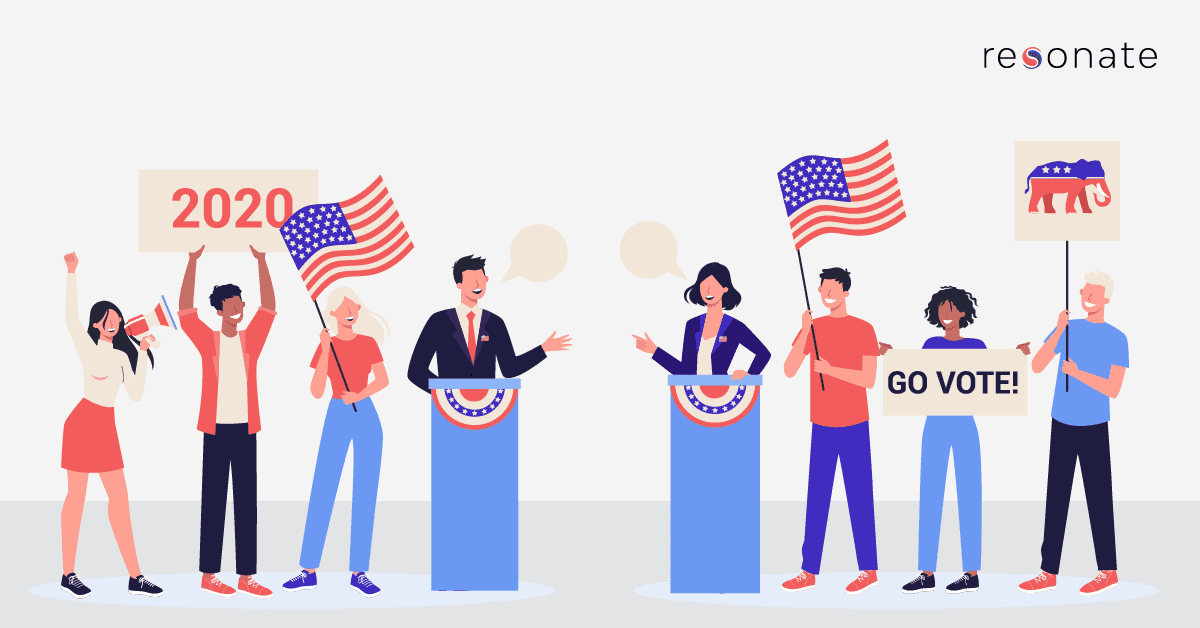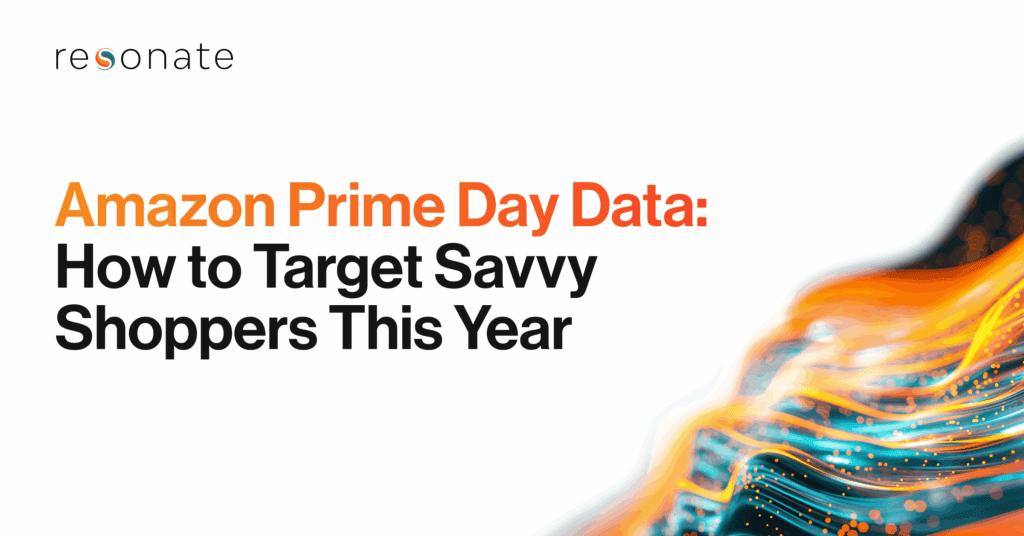Wednesday’s Vice Presidential Debate was more of the battle for American hearts and minds that voters expect to see every four years, when the leaves begin to change and the country braces for new beginnings.
The widely accepted takeaway is that both candidates pleased their bases. Senator Kamala Harris, no stranger to courtroom conflict, prosecuted the case against the Trump Administration. Vice President Pence, with a tenor made for radio, sought to reassure Americans that the country is on the right path. Both sides claimed victory, but here are some clarifying questions campaigns should ask:
What’s the deal with fracking?
The fact is, campaigns everywhere are now competing for an increasingly small slice of swing voters. That’s why you heard the word fracking 10 times Wednesday night.
Why fracking? Because both candidates need to win working class voters – in pivotal battlegrounds – to have a shot at 270. A thriving energy sector – at the core of the American heartland – was nailed this year by a perfect storm of low oil demand and the COVID economy, resulting in lost jobs and anxious families in the most politically coveted states.
Resonate data show that by and large, the majority of voters are either persuadable or oppose fracking – rather than support – but this race is no longer about the majority, it’s about the Electoral College. Hence the unabashed support for fracking from both VP candidates.

Data for online registered voters showing only 26.3M voters support fracking, while 75.5M oppose and 120.6M remain persuadable
For swing state voters with economic ties to oil, you can bet they’re listening for where the candidates land on fracking. Consider that a fracking ban would cost Ohio about a half million jobs. Even states like Wisconsin, that produces zero oil, directly support nearby oil-producing states with homegrown resources crucial to the fracking process.
In case you missed it, Resonate released a blog after the first POTUS debate that provided critical insights – available for immediate targeting – on white working class swing voters in these decisive battleground states. This remains an audience that campaigns will need to fight for until the clock runs out, personally connecting with their values, motivations, and recent hardships.
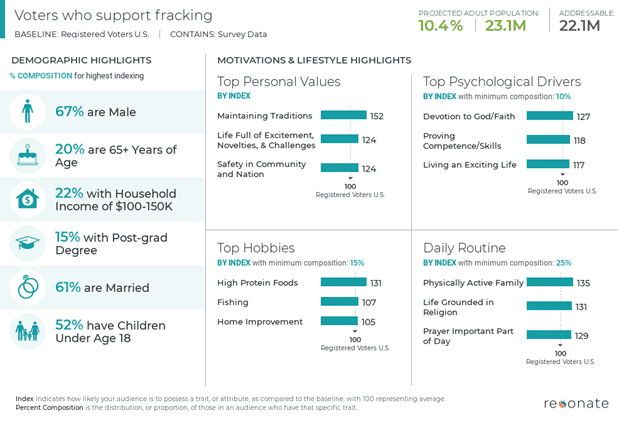
Online registered voters who support fracking
Whether it is an issue like fracking, healthcare, entitlement benefits or foreign policy, the Resonate platform is modeling how voters online view the most important issues in the context of the 2020 election.
Are campaigns paying enough attention to 65+ voters?
After the first presidential debate and ahead of the VP debate, new polling showed Biden with a 27 point lead over Trump with 65+ voters. Consider that in 2016, Trump won 65+ voters by roughly 10%. Are campaigns paying enough attention to this audience?
After the VP debate, we turned to our online behavioral models to help campaigns better understand this decisive audience. Specifically, we looked at an online universe of 5.4M registered voters who are 65+ and known swing voters in recent elections.
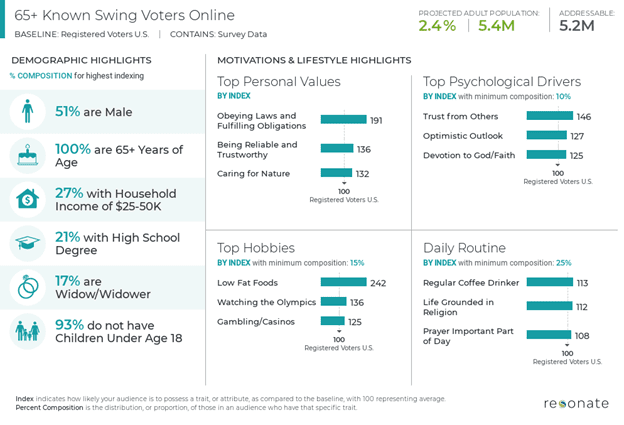
If the election were held tomorrow, our models show that Trump and Biden share exactly equal support with this swing audience at 42% each, while only 9% would not vote and another 7% would back a third-party candidate.
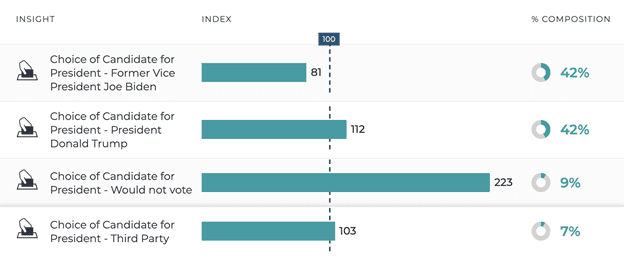
To connect with 65+ swing voters, Harris was smart to focus on Trump’s handling of the coronavirus. In fact, this audience is 21% more likely to support a presidential challenger as a result of the coronavirus situation. At the governor or state level, these voters are 39% more likely to have changed their voting intention due to Covid-19. This should put down ballots on notice.
On the issues, our 65+ swing voter audience – compared to your average voter – are:
- 80% more likely to believe China is a threat to long-term U.S. interests (Pence highlighted Trump’s aggressive China-focused policies, including tariffs and placing the Coronavirus blame on the Chinese)
- 66% more likely to support candidates that display bipartisanship (Harris alluded to Biden’s broad coalition of political support, including several prominent members of the Bush White House)
- 58% more likely to believe improving infrastructure should be a Trump priority (Harris pointed out Trump’s lack of delivery on infrastructure investment)
- 51% more likely to oppose the Green New Deal (Pence called out Harris’ previous support and co-sponsorship of the Green New Deal in the Senate)
As demonstrated by the above insights, both VP candidates would have connected with our 65+ swing voter audience at certain times in the debate. How is your campaign doing with these voters?
Looking ahead
Whether your campaign needs to lock-in support from senior voters or tap into specific policy leanings like fracking or Obamacare, Resonate can have your message in front of your target audience within 24 hours.
Ready to target and win the voter segments you need? Request a demo or contact us by phone at 855-855-4320.
